Cosmos care and growing guide: expert tips on these well-loved summer annuals
Learn how to grow cosmos for easy-going blooms that will fill your garden with long-lasting loveliness
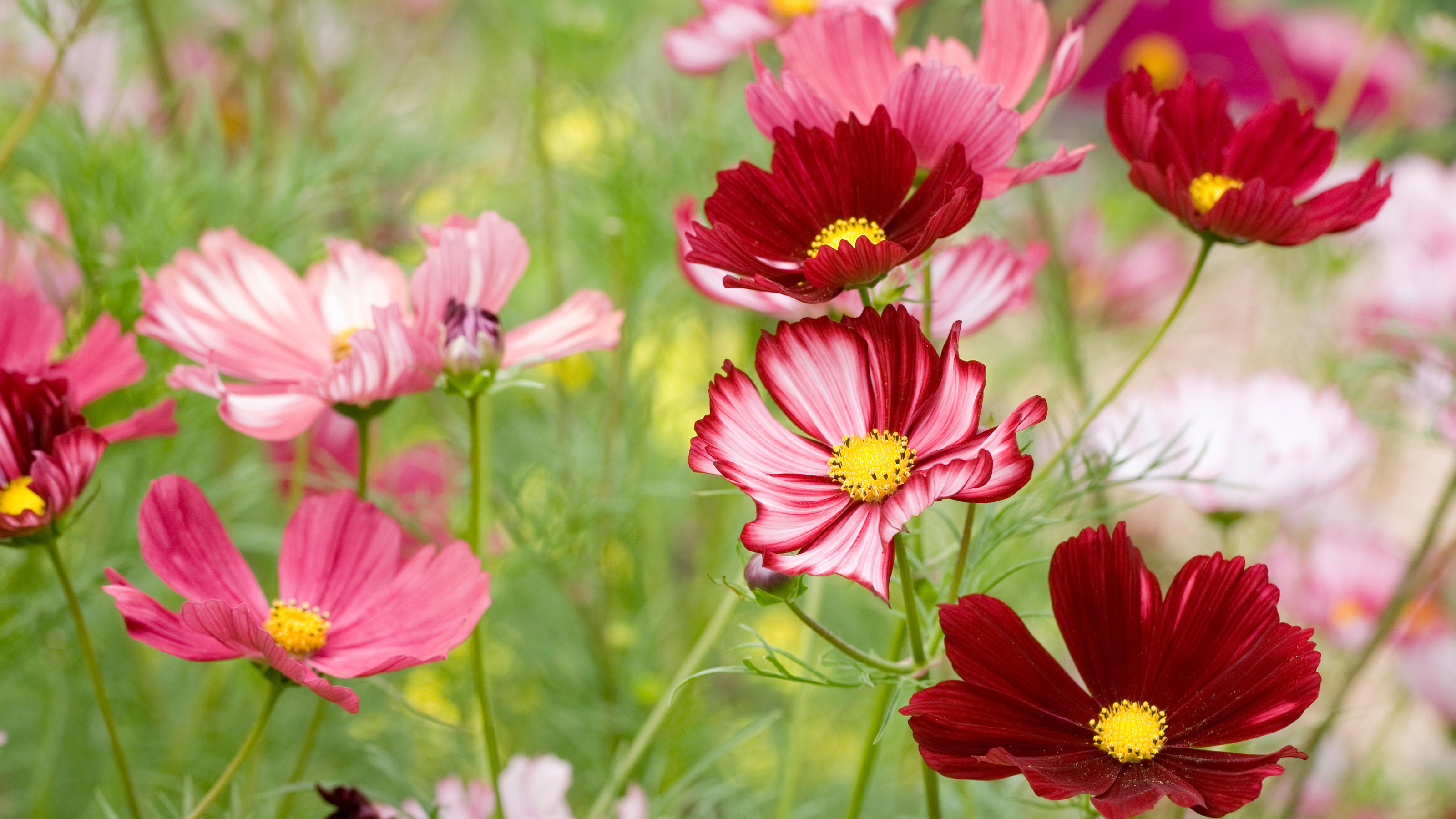

Cosmos, sometimes called cosmea or Mexican aster, are sun-loving plants with saucer-shaped flowers like daisies. They are very colorful and easy-to-grow flowers that are usually grown as annuals from seed sown each spring and then pulled out in the fall. Some may survive the winter in USDA zones 8 or 9.
Whatever your gardening aspirations, cosmos make ideal planting options for all manner of flower bed ideas, complementing the most elaborate cottage schemes or the most casual wildflower arrangements. Some varieties bloom happily at knee height, flowering on short plants about 12–15in (30–38cm) tall. Other breeds can reach head height, 5–6ft (1.5–1.8m), with different varieties at all heights in between.
All cosmos have flowers with the same general appearance. In the center of each flower are rings of tiny individual flowers (florets) which form an eye or disk. Starting from the outside of the disk, each ring of tiny florets opens one after the other to shed pollen for the bees to collect. Usually, these florets are yellow, orange, or gold, though they can be reddish.
Surrounding the disk are the petals (rays). These are large and colored brightly in a range of tones to attract pollinators to the flowers. The leaves are usually fine and feathery, but can be flat and narrow.
Cosmos have large, easy-to-handle seeds that sprout soon after sowing and grow strongly. This guide has all you need to know on cosmos care so you can add to your wildlife-friendly gardening display with these elegant, easy summer blooms.
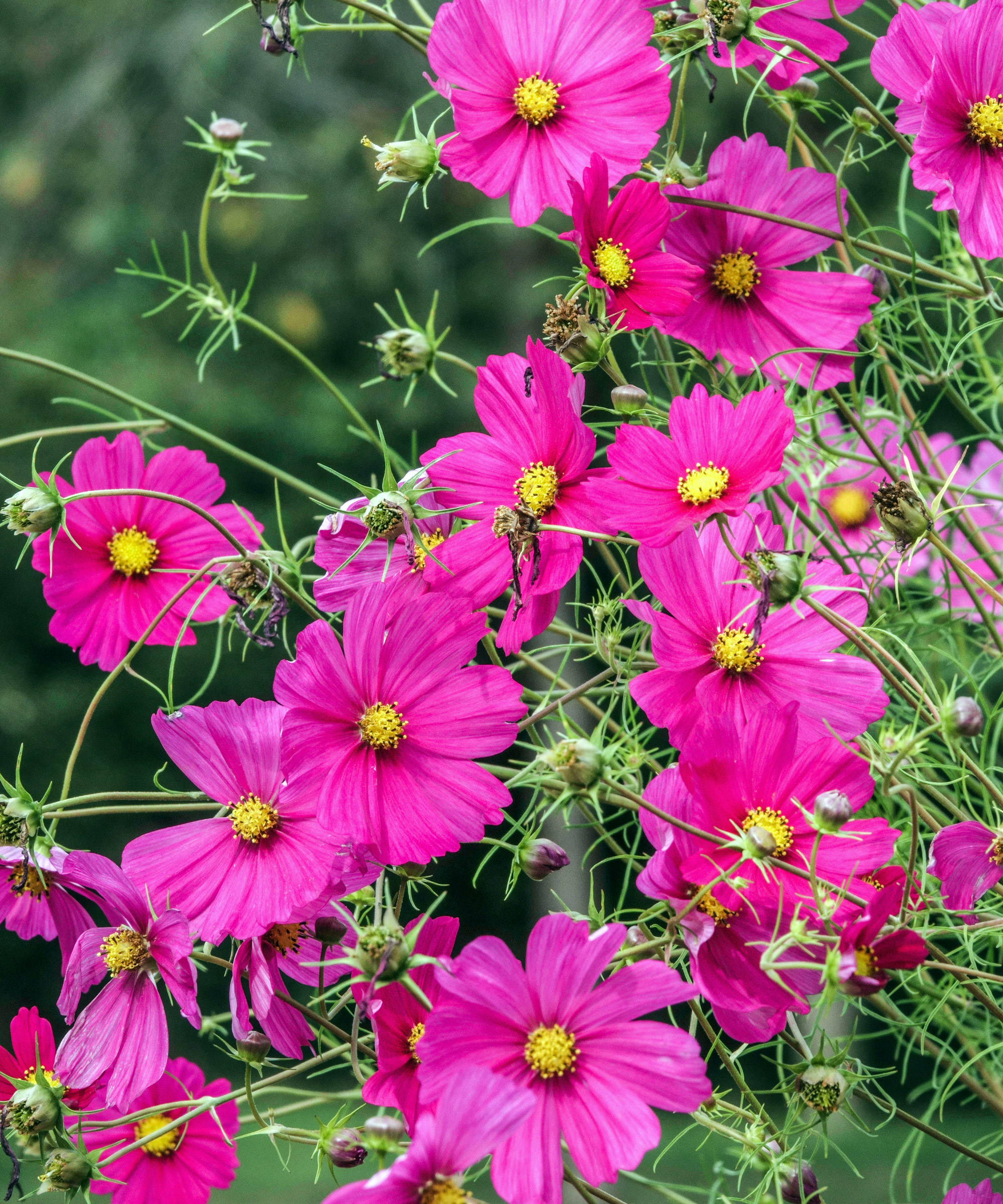
Cosmos bipinnatus 'Rubenza' is a short cosmos variety that works well in sheltered spots and is ideally suited to the cutting garden
Where to plant cosmos
All cosmos prefer plenty of sun. Partial shade tends to encourage the plants to stretch, meaning they will need support to prevent them from falling over. Flowering will also be less prolific than it would be in the sunshine.
These plants dislike wet or parched soils but will tolerate drought once they are well established. Rich soils encourage soft, weak growth and are best avoided.
There are three main types of cosmos, and this has some bearing on where you plant them. Garden cosmos (Cosmos bipinnatus) are the most likely to appear in seed listings, and these plants do best in well-draining soils with a neutral pH (6–8). It can help to familiarize yourself with the different soil types in your garden. If your soil is especially acidic, add some lime.
Sulfur cosmos (Cosmos sulphureus) are also undemanding. They are a bit more drought tolerant than garden cosmos. Again, parched and wet soils and very fertile conditions are best avoided.
The final type, chocolate cosmos (Cosmos atrosanguineus), is a zone 8 perennial. This is often best planted in a container that can be moved into protection in winter. It can also work in well-drained soil incorporated into graceful south-facing garden ideas or at the front of a sunny border with a wall behind. These cosmos are some of the best plants for garden walls as the height provides shelter from the worst winter weather.

All types of Cosmos bipinnatus do best in full sunshine
What is the best variety of cosmos for your garden?
Different types of cosmos can be grown in different parts of the garden. Depending on whether you are looking to grow something specifically in beds or garden borders, in containers or in a cutting garden, the following can help you determine where to plant your choices.
- Flower beds and borders: All three types of cosmos can work. Tall varieties of garden cosmos (around 4–5ft/1.2–1.5m), including 'Daydream' (pink and white bicolor), 'Psyche White' (semi-double white flowers), and 'Sensation Pinkie' (rose pink), can be grown at the back or the middle ground. They make good low maintenance garden border ideas to try. Medium-height varieties (2–4ft) such as 'Apricotta' (peachy pink), 'Rubenza' (ruby red), and 'Xanthos' (lemon yellow) can go in the middle ground or the backs of small borders. 'Polidor', the vivid yellow, orange, and red variety of sulfur cosmos, also fits here.
- Pots and containers: For container gardening ideas, only the shortest cosmos varieties are recommended. In the garden cosmos category, go for 'Apollo' in four colors, including a pretty pink-and-white picotee, at 18in (45cm). If 'Apollo' is hard to find, try the slightly taller 'Sonata', which is 2ft (60cm). 'Brightness' is the sulfur cosmos to go for in hues of red, orange, and primrose. Containers are also ideal for the chocolate cosmos – 16–24in (40–60cm) – as the flowers are raised to a height where they are easier to smell.
- Cut flowers: All except the shortest cosmos make good cut flowers for your cutting garden. In the taller types, those with double flowers last the longest when cut. Look for 'Double Click' – the cranberry red and the pure white are especially pretty – and the 'Sea Shells' blend with its petals rolled into tubes. Chocolate cosmos can also be picked to bring that special scent to posies.
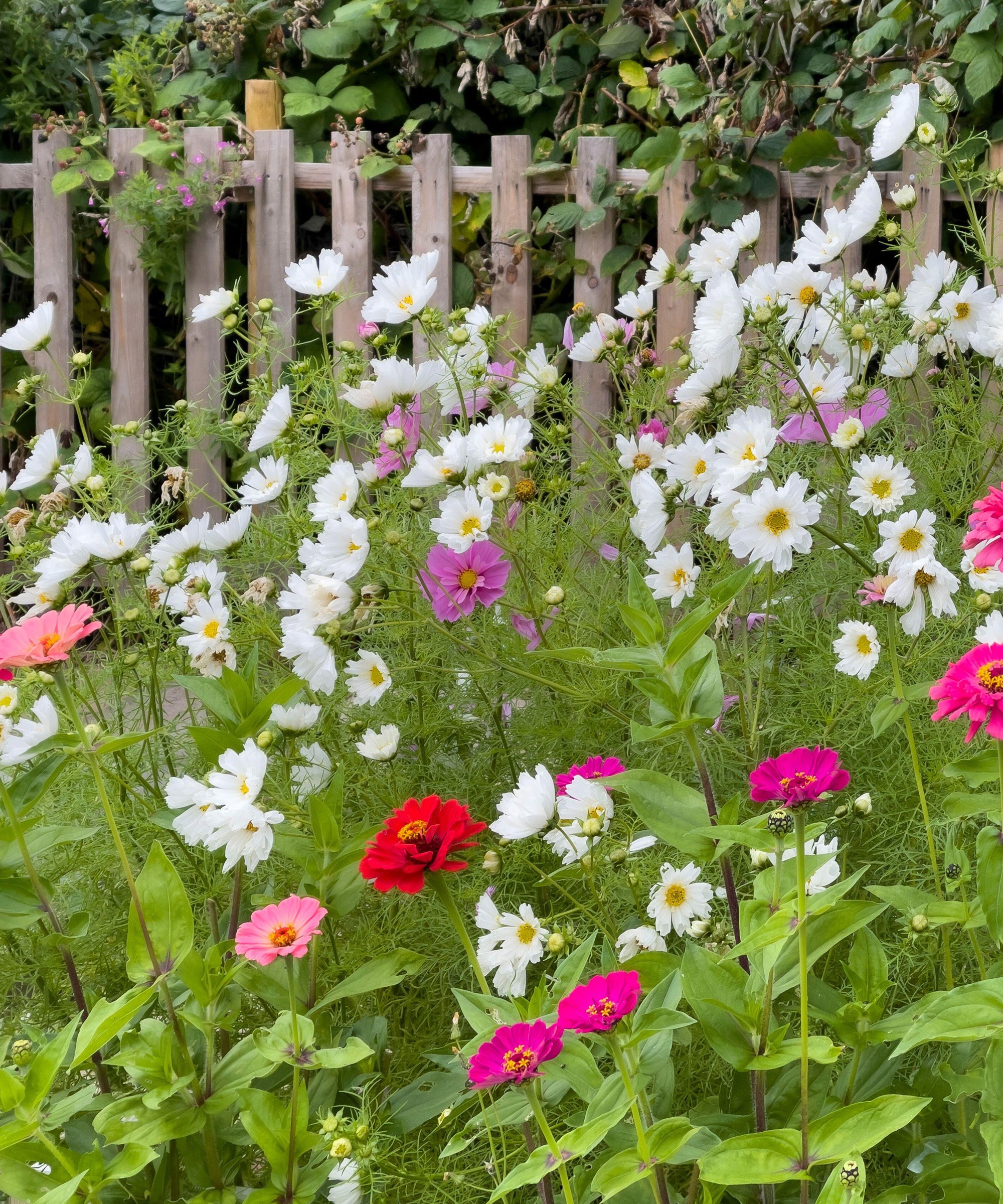
Tall Cosmos 'Psyche White' is ideal at the back of a border
When to sow and plant cosmos
Garden cosmos seeds can be sown outside where they are to flower at around the last frost date in your area.
However, where summers are likely to be short, plants grown from seeds sown outside may not develop to their full size before flowering. So, it is usually wise to sow four to six weeks before your last frost date, either on a windowsill, in a frost-free conservatory or sunroom, or under grow lights.
Seeds of sulfur cosmos can also be sown outside where they are to flower in spring. However, they prefer warmer conditions, so this usually only works well in the south or zones 8–11. In other areas, it's best to raise the seedlings in a frost-free situation. You can then transplant seedlings outside once they have been hardened off.
Keep the seed packets after sowing, as they usually provide useful care details. Plants of both garden and sulfur cosmos types can be planted outside after the last frost date in your area.
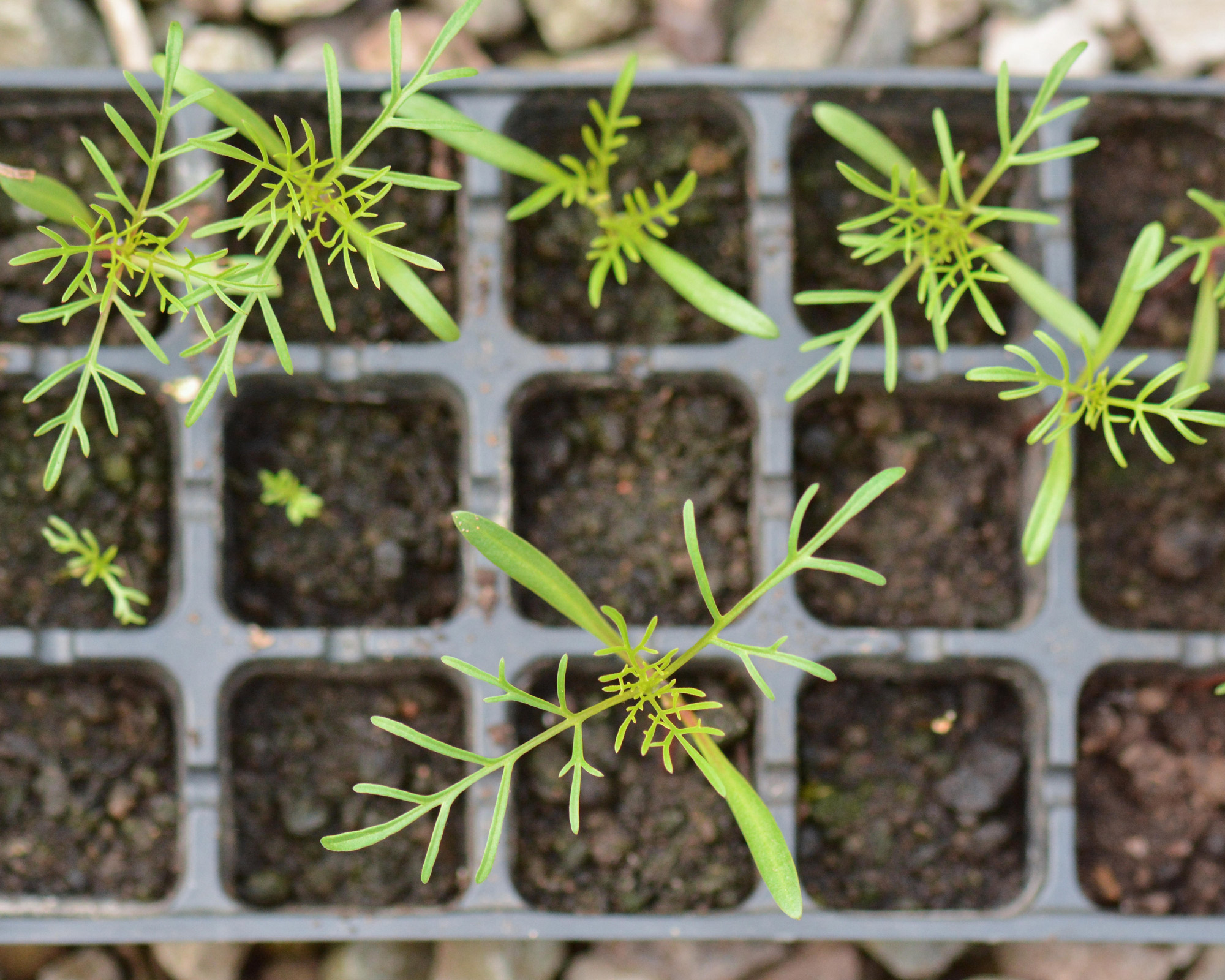
Sow seeds in pots and trays four to six weeks before the last frost date and keep them in a warm place
How to plant cosmos
There isn't much technique to factor in when figuring out how to grow cosmos. There are just a few basics that can help ensure the longevity and vibrancy of these cheerful summer displays.
- First, prepare the planting area. It's a good idea to get rid of weeds and large stones. If the soil is particularly poor, amend it with garden compost, rotted cow manure, or other organic matter.
- Space the plants out across the planting area, checking the tags or seed packets for spacing details. If in doubt, set dwarf types 9–12in (23–30cm) apart, and the tallest 2ft (60cm) apart, with medium-sized varieties somewhere in between. Remove the pots or trays and plant with a hand trowel, firming gently.
- Then, water in with a general-purpose liquid feed.
The beauty of planting cosmos is that there is no need to be precise. These plants grow agreeably together – they don't compete – and they look incredible scattered here and there.
If you know how to grow echinacea, rudbeckia, and daisies, you will be familiar with this idea and how effective it can be, displayed in haphazard sweeps.
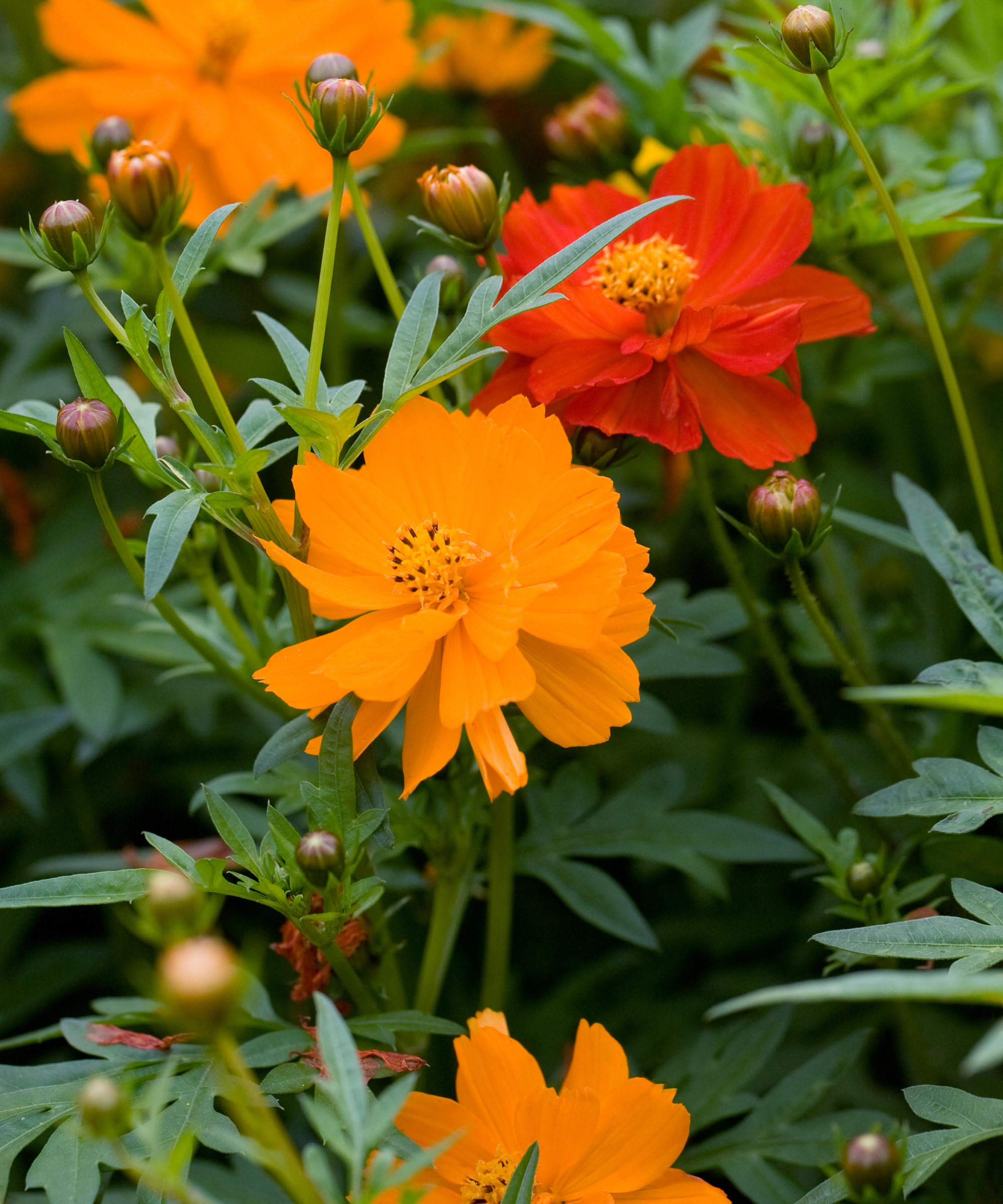
Although you need to provide adequate spacing between plants, precision isn’t needed with plantings like these 'Brightness Mixed' cosmos
How to care for cosmos
Cosmos care is simple once you know how.
Although gentle and natural sweeps of cosmos look amazing, you can apply a little more intervention to your cosmos after planting, in order to perfect the spacings. When outdoor-sown seedlings come up and start to develop leaves, check the final spacings recommended on the seed packet. Snip off some of the seedlings at soil level with kitchen scissors, leaving them at half the spacing suggested on the packet.
Two or three weeks later, snip off some more to leave plants at their final spacing. At this stage, if there are unsightly gaps in plantings, you can transplant seedlings into the spaces instead of snipping them off.
Irrigate in dry spells, and support taller varieties with canes and string. Another wise practice is deadheading flowers with snips or your best secateurs as they fade. This will encourage more flower buds to develop, meaning blooming should continue until the first frosts.
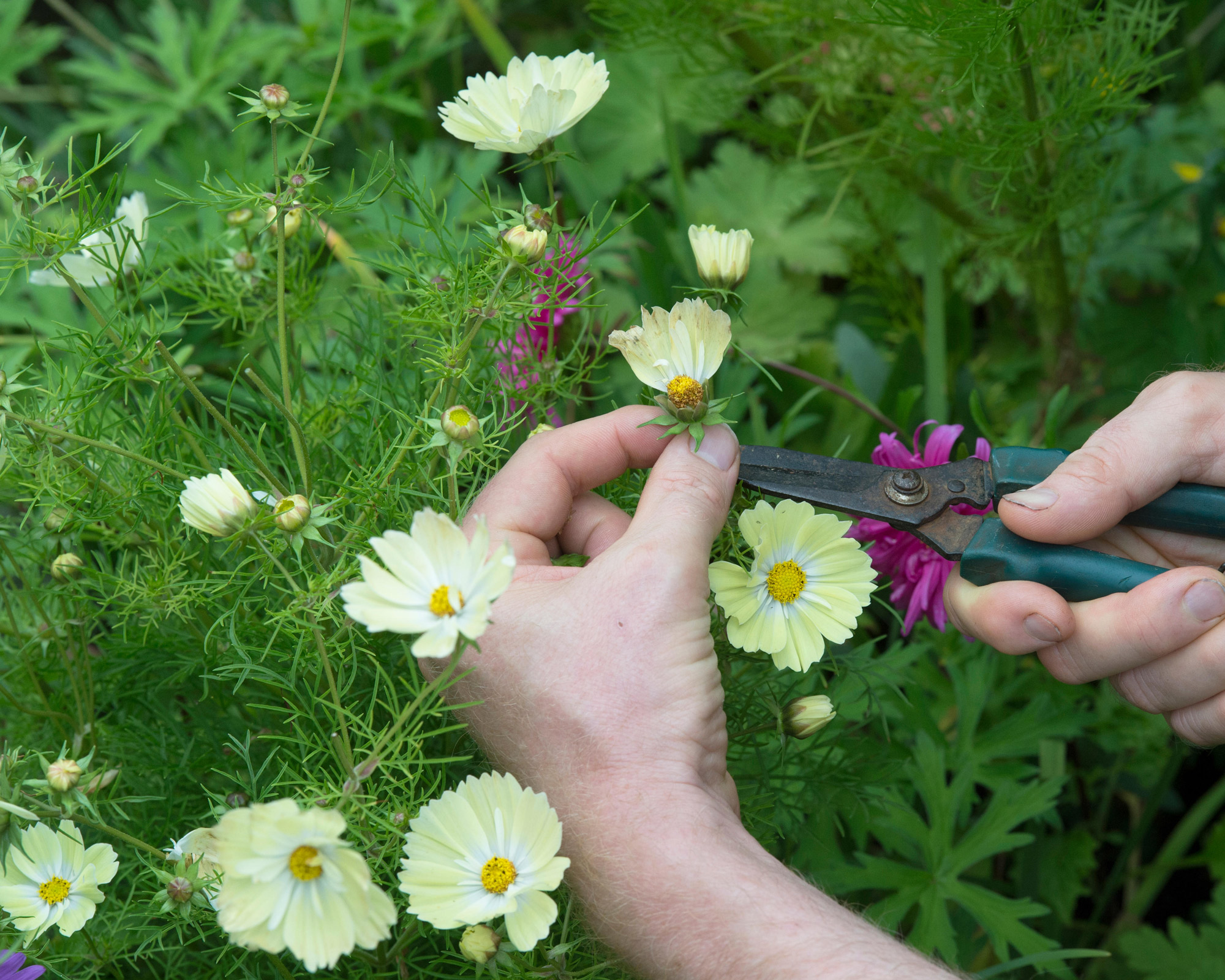
You'll find that deadheading often is a great way to promote more flowers in summer displays
How to propagate cosmos
Getting more cosmos for free is easy – but you have to wait until the end of the flowering season. Instead of snipping off the faded flowers on garden cosmos and sulfur cosmos, just leave some of them to develop seeds. Then you have a couple of options for making more cosmos.
One approach is to cut off seed heads when they turn brown and dry them in an envelope. Then you can grow flowers from seeds all over again. These seeds can be sown in the spring.
Alternatively, you can allow the seeds to drop in the fall. Some will germinate in the spring. Just bear in mind that chocolate cosmos does not produce seeds.
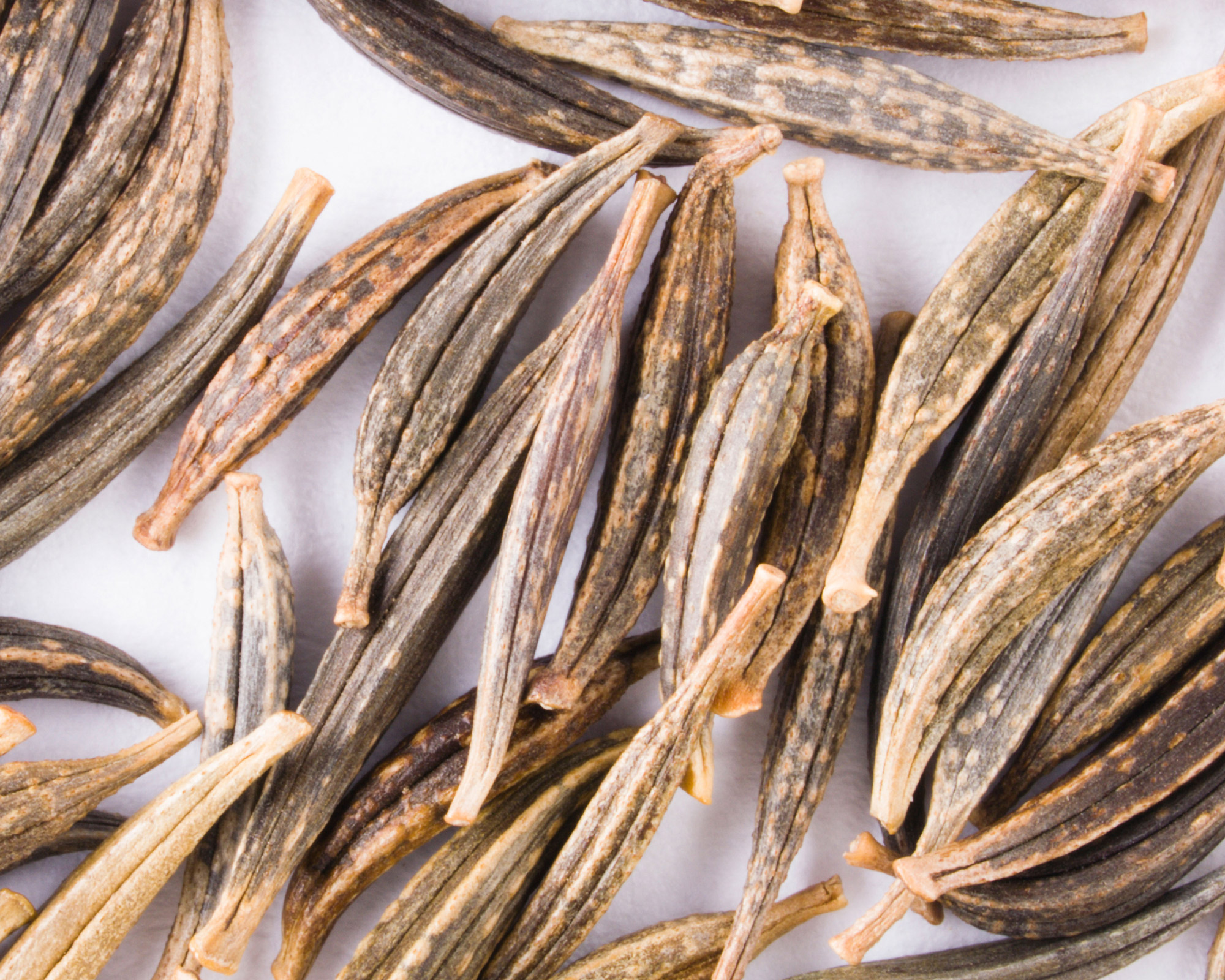
Collect some seeds from faded flowers and dry them in an envelope
Common problems with growing cosmos and how to solve them
For cosmos, the big pests are slugs and snails, which can wipe out all your seedlings in spring. They can attack seedlings grown in a propagator or under lights, as well as outside in the garden. So, it pays to know how to get rid of slugs, and to be vigilant.
Aphids, greenfly, and blackfly can also be found on seedlings right through to mature plants. Sometimes these pests will damage seedlings being grown indoors. If you want to know how to get rid of aphids, encouraging pest predators will always help. You can also squeeze them between thumb and forefinger, or use an organic insecticide.
In areas with high summer humidity, mold can also be a problem. To help with this, remember to keep an eye on spacings. Space the plants out more widely if needs be to improve air circulation. Use an appropriate fungicide as a second line of attack.
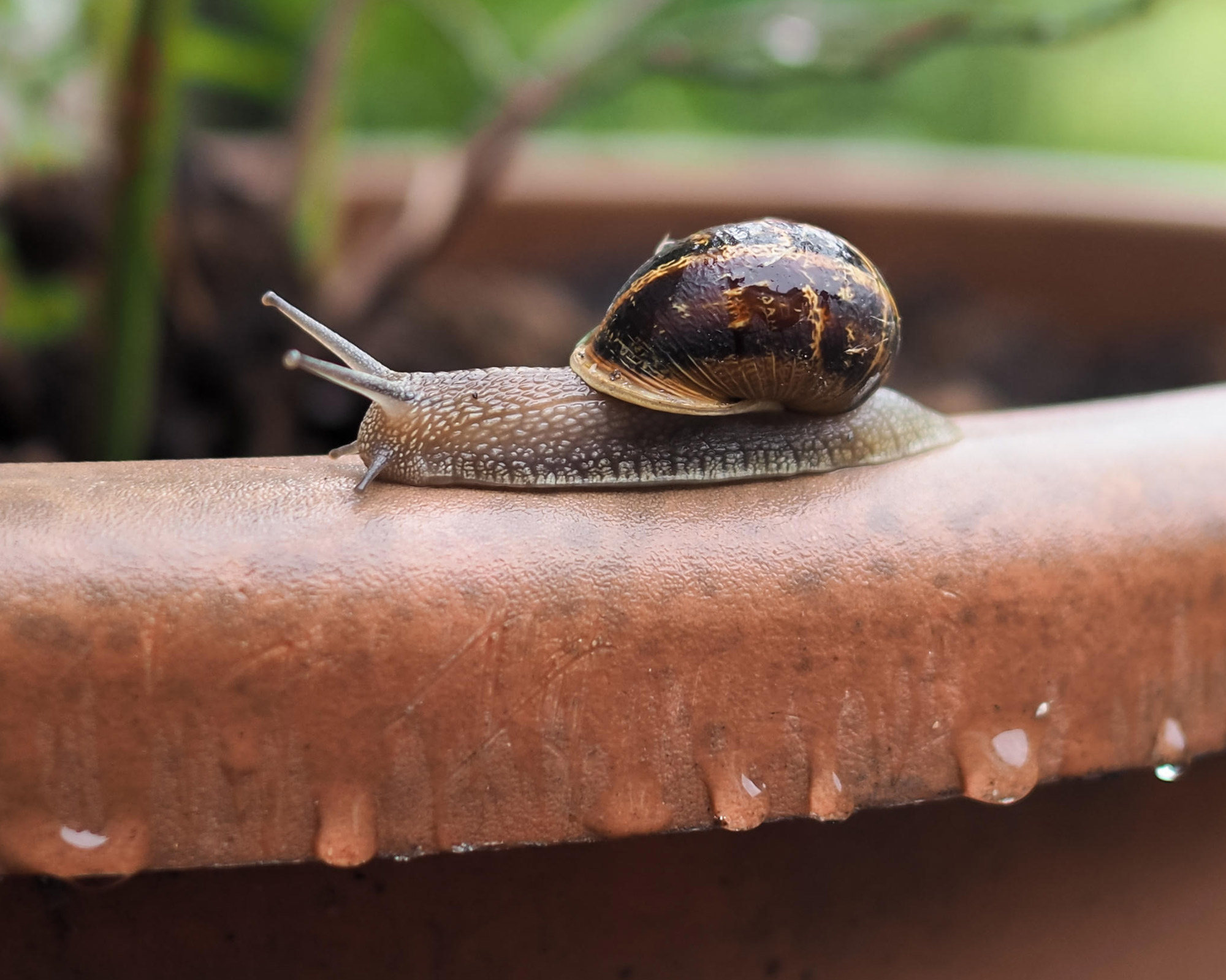
Snails can be a problem with seedlings, so be vigilant
How do you grow cosmos in pots?
Keen to grow cosmos in pretty garden planters?
Some garden centers offer the plants potted up in containers, ready to take home as they start to flower. These give you a flying start on your daisy-themed patio gardening ideas, and will also look stunning positioned by your front door.
Smaller plants can go into containers of fresh, moist potting soil. Follow these tips to get the most from your container-grown cosmos:
- Choose new containers or be sure to wash out last year's planters. Do not use last year's soil or soil dug from your yard.
- Give your young plants a dose of liquid feed, then fill your container almost full with potting soil.
- Make a hole in the potting soil with your fingers, slip in a young plant, and adjust the level so that it is an inch below the rim of the container.
- Firm gently, then water from a can or hose. Do this until water emerges through the drainage holes at the base of the container.
For pots, medium-sized and dwarf cosmos varieties are preferred, which makes them particularly suitable for small garden ideas, patios, and balconies.
Tall varieties can be rocked by the wind, and their roots are too vigorous for containers.
Plant one in a 12in (30cm) planter, or three in an 18in (45cm) container. For a larger display, place four or five in a 24in (60cm) planter with smaller plants around the edge.
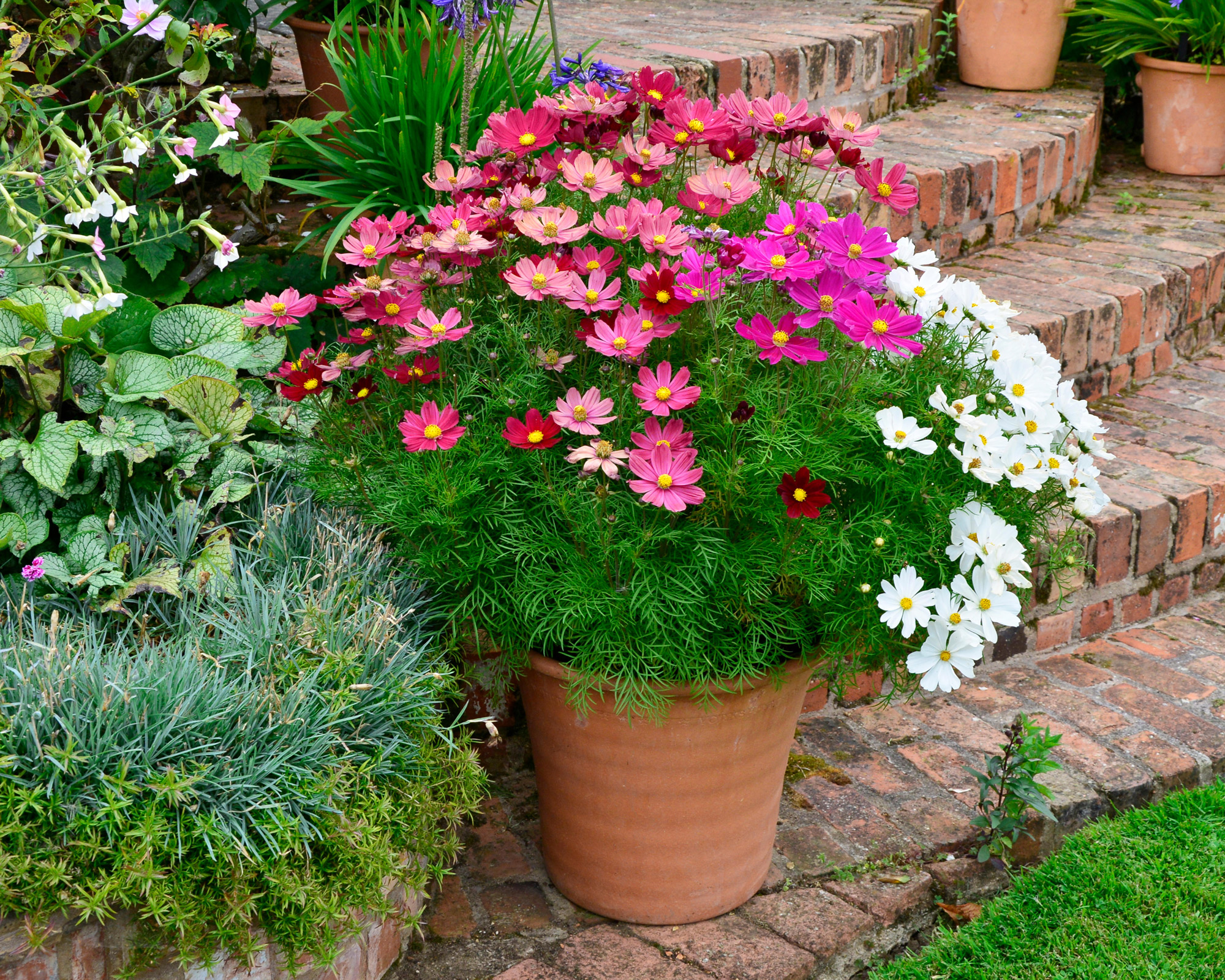
Choose dwarf or medium-sized varieties of Cosmos bipinnatus for pretty pots
Why are my cosmos tall and spindly?
If you sow cosmos seeds in a pot on the windowsill, they may come up quickly but might be very tall and spindly (or 'leggy' as this condition is also known). If you're wondering what went wrong, it's principally about the light source. Leggy seedlings will indicate either a lack of light or light coming from only one part of the plant's growing area.
Cosmos (just like any other plants raised from seeds) need plenty of light – and this light needs to be multi-directional. In dim or unevenly lit places, the seedlings will stretch in order to reach brighter light.
High temperatures (more than 60°F/15°C) also encourage tall, weak growth. Choose a place that is bright, but not sunny, for your seeds and seedlings, and make sure it is warm, but not hot.

Provide ample light to prevent plants from becoming leggy
Where do cosmos originally come from?
In the United States, you might see pink and white cosmos growing by the freeway and wonder if they are native to the USA. In fact, these plants are native to Southern and Central America. They originate in the meadowlands and scrublands of Mexico. This is part of the reason why they are such sun-lovers, and it also explains why they prefer soil that is well-draining and not too rich.
Cosmos do not grow wild naturally in North America. However, seeds of garden cosmos are sometimes included in the mixtures scattered by highway departments to brighten the banks at intersections.
If you know how to plant a wildflower meadow, you can see how repeat displays might then have come about. Much like wildflower plantings, they will often drop their seeds and then come up for many years. Sulfur cosmos is also planted near highways in the south and may also escape from gardens, and will keep coming up year after year.
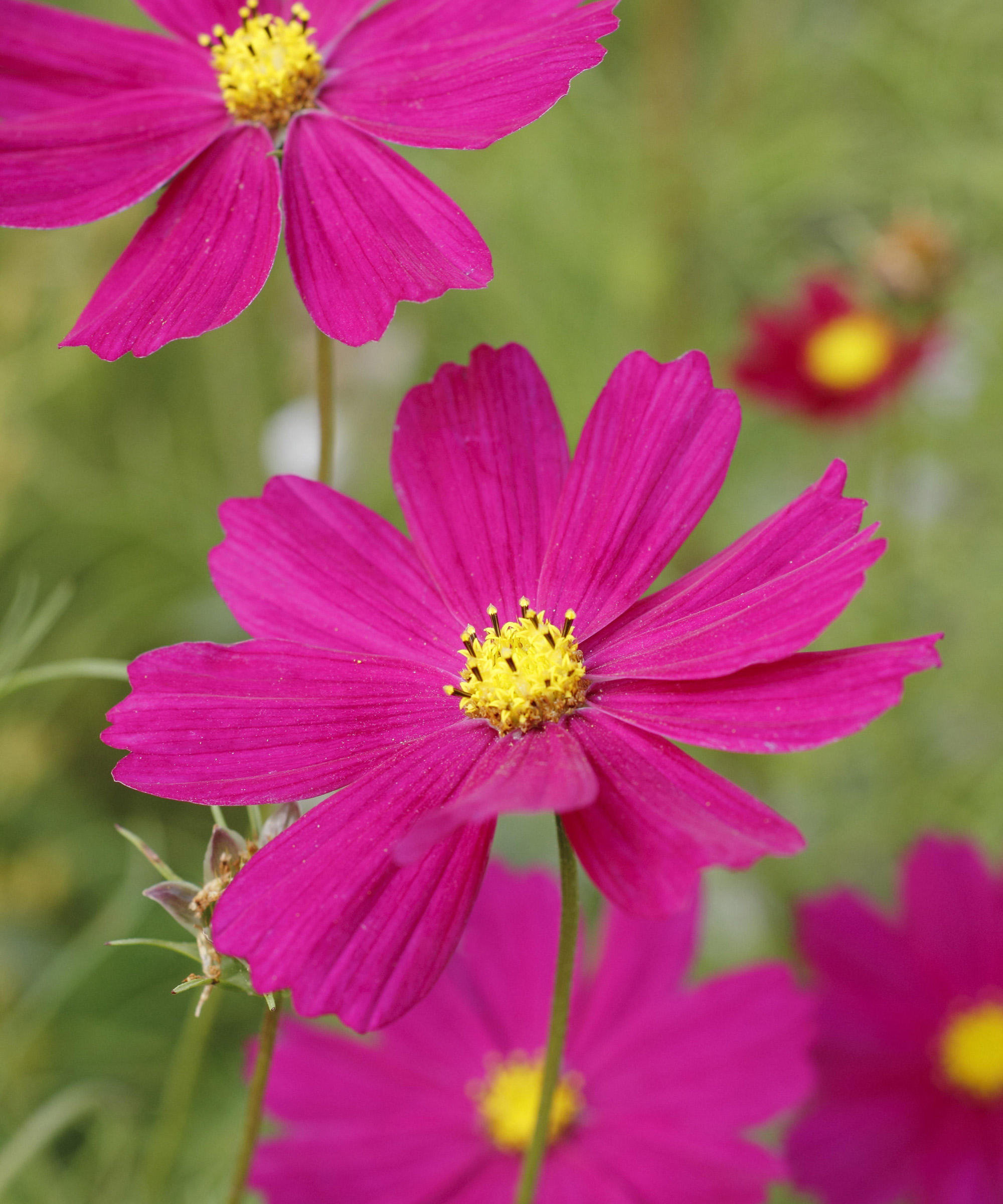
If you see cosmos growing by the roadside, chances are they have been deliberately sown by highway departments (this is ‘Dazzler’)
Are cosmos deer resistant?
No, deer will eat your cosmos if you have them in your yard. Fencing is the most reliable option to prevent this, although some communities do not allow fences that are tall enough to be effective.
Deer deterrents sometimes work, but will need constant replenishment. If you are interested in deer-resistant plants, consider asking at local nurseries and at your local Cooperative Extension Service for advice tailored to your particular area.
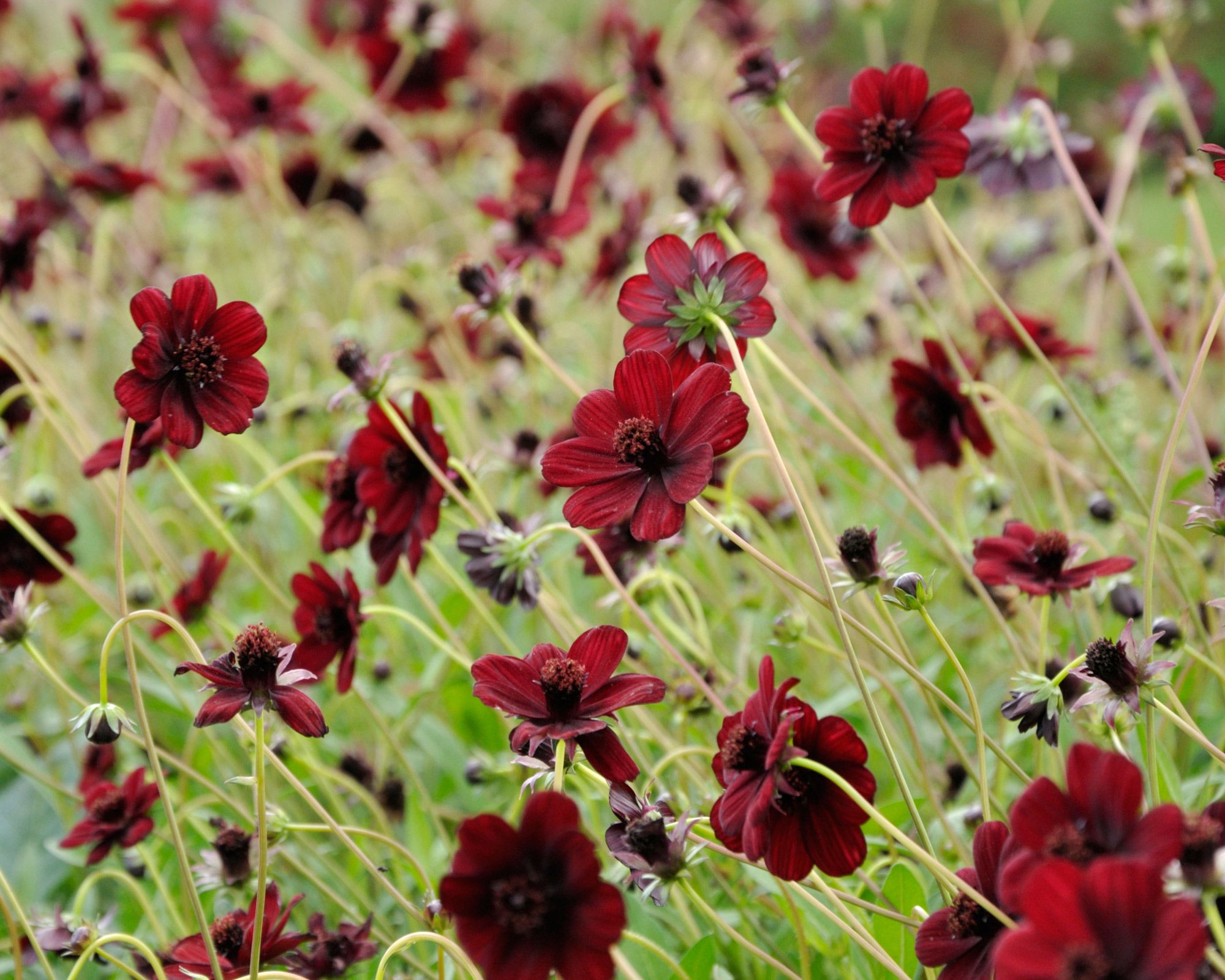
Chocolate cosmos (Cosmos atrosanguineus) is readily available to buy at several online stores
Where to buy cosmos
Garden cosmos are usually bought as seeds in mixed blends or in separate colors. They are available from discount stores, nurseries, and garden centers, but the best choice of varieties is available from mail-order suppliers.
Small seedlings are sometimes available by mail order. Small individual plants in pints, and packs of young plants, are also available by mail order.
Alternatively, young plants in various sizes and packs of six or 12 are often available in retail stores. Larger individual plants, in up to three-gallon planters, are also available for retail pickup.
Sulfur cosmos seeds are less often seen in nurseries and garden centers, but are usually listed by mail-order companies.
Chocolate cosmos is rarely grown from seeds, but plants are sometimes seen in high-end nurseries. Plants and dormant tubers can be found by mail order.
Use our quicklinks to find some stunning cosmos varieties for your plot:
Where to buy cosmos in the US:
- Shop cosmos seed at Amazon
- Shop cosmos seed at Burpee
- Shop cosmos seed at Stokes Seeds
- Shop cosmos seed at Swallowtail Garden Seeds
- Shop cosmos plants at White Flower Farm
- Shop cosmos seed at Walmart
Where to buy cosmos in the UK:

Graham Rice is a garden writer who has won awards for his work online, and in books and magazines, on both sides of the Atlantic. He is a member of a number of Royal Horticultural Society committees and the recipient of the 2021 Garden Media Guild Lifetime Achievement Award.
